Rutgers University Connects Campuses With Immersive Video
The eighth oldest higher-education institution in the United States, Rutgers University has grown and expanded to encompass more than 6,000 acres of campus spread across three cities in New Jersey, with several additional sites around the globe. So, it may come as no surprise that when the college conducted a full analysis of the educational experience offered to its 70,000-plus students, one of the most striking findings was about the excessive amount of time that students and faculty spent in transit between various learning facilities.
Which is why Rutgers implemented a multi-phase plan to reduce the travel burden and improve the educational experience generally as the school heads into the future. This included schedule optimization and other strategic upgrades prescribed in Rutgers’ forward-looking 2030 Physical Master Plan. But it wasn’t just logistical moves that were made, this visionary plan also produced a bold new technologically enhanced method for moving the classroom experience closer to students.
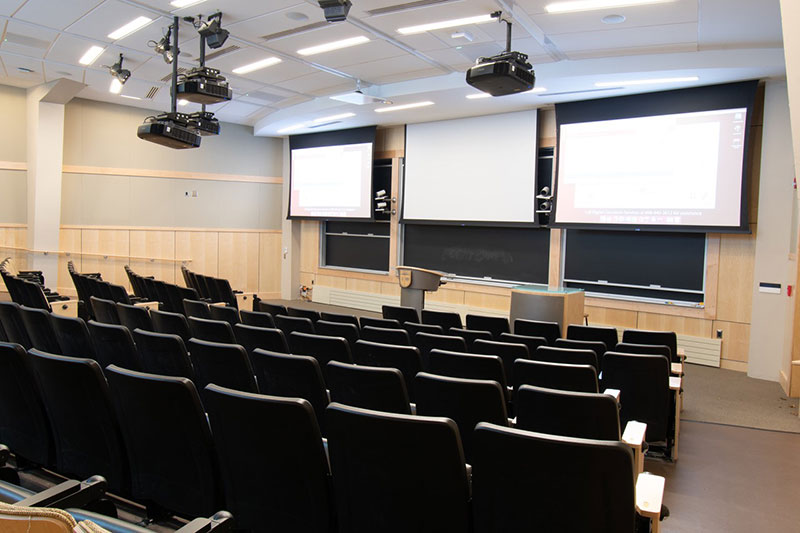
Separated by three miles across a river, the Busch and Cook/Douglass campuses of Rutgers University used an advanced video system to bridge the distance between two classrooms by creating “Immersive Synchronous Lecture Halls.” By sharing a course’s content across two rooms, with the professor alternating between each space to provide equal in-person instruction, the goal was to allow students to choose their ideal location.
But this virtual connection wasn’t just your standard videoconference or distance learning setup, according to Matthew Wilk, Associate Director, Technical Services and Operations, Digital Classroom Services at Rutgers. “We really wanted to try to match a synchronous, immersive environment where the students and the faculty feel they are in the same room,” he says. “We’ve all been in videoconferences where someone is speaking, and it’s the ‘Wizard of Oz head.’ We don’t find that to be really conducive to having a classroom experience. Nobody really wants to sit there and listen to a talking head.”
To avoid the disembodied head limitation, the video capture and display systems for these campus-connecting classrooms were designed to be as human-scaled as possible. “The students are seeing a life-size version of a person on the screen,” Wilk describes. “And the students can also see their classmates in the other classroom on the screen, so they feel like they are all in one room, just separated by location.”
With a realistic image of the people on either end of the video connection, it’s easier for students to have a natural interaction and even to feel like they’re making eye contact with an instructor. “The cameras are set up in such a way that when the students reach out, or they’re talking to someone at the other end, they’re making eye contact, and they feel it,” says Tim Van Woeart, Senior Project Supervisor, Digital Classroom Services at Rutgers. “They can tell that the professor is looking at them individually.”
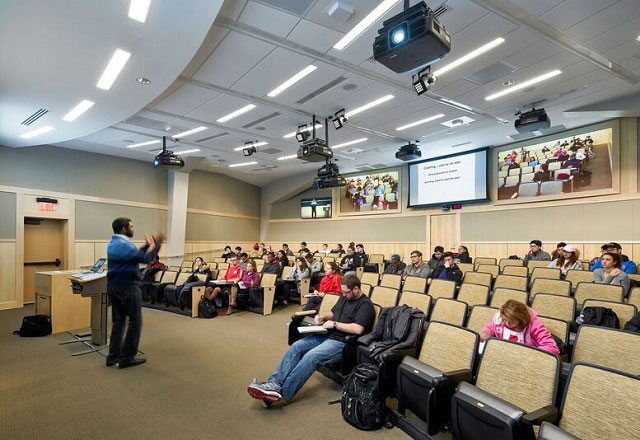
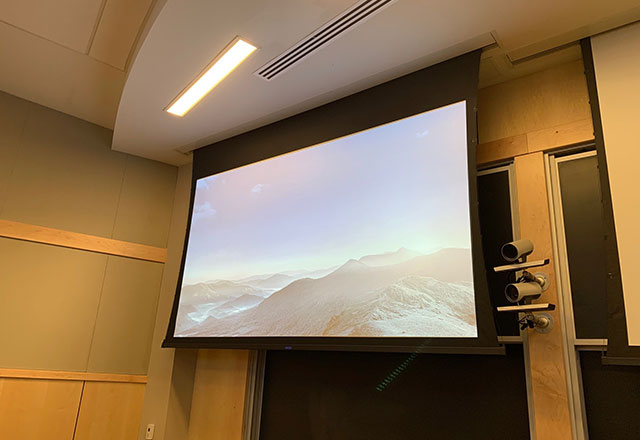
Altogether, the full-scale video and carefully planned sight lines result in creating a more close-knit feel among what is really a large number of classmates. “Even when we’re talking about potentially up to 250 students, which is the size of one of our large lecture halls, it has the intimacy of a 125-seat small room,” notes Van Woeart.
Further enhancing the effect of one large, shared classroom is the sound system setup. So that students can speak naturally, microphones in the room are always live and ready to pick up comments and questions. No need to wait for a microphone or have technology get in the way of the exchange.
The video can follow the audio, as well. An instructor has the option to use a feature where the cameras will automatically zoom in on the section of the classroom where a voice is picked up by microphones. This feature was also designed to have a natural feeling. Rather than a quick, jerky move to another visual, as would happen during a standard online video chat, the zooming camera gets into position first and focuses before the video switch is made. “It’s a very seamless transition as if you were watching on TV,” Van Woeart says.
That level of human-centric design consideration also went into the use of the system. The Digital Classroom Services department at Rutgers has made significant efforts to unify the operation of classroom technologies campus-wide, such that when an instructor walks into a new space, they will find a familiar setup for using the audiovisual equipment in the room.
Walking up to the room’s podium, an instructor will find the Rutgers Room Controller, an interactive touchpanel that handles everything from lighting to visual displays and sound. And the experience will ideally be as reassuring as turning to a familiar smartphone interface. The controls and buttons are standardized across all rooms, and the layout of the control screen is clean, simple and easy to use.
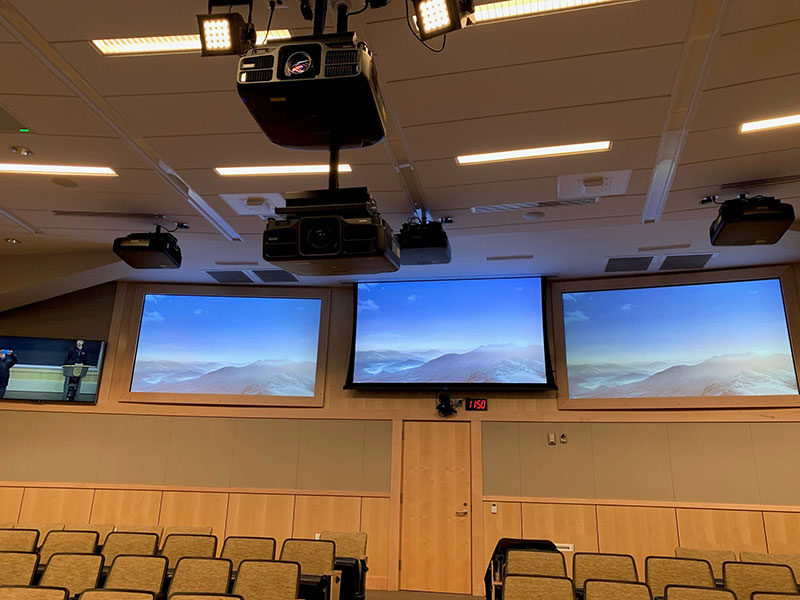
With the Rutgers Room Controller handling the operation, even the fully immersive setup of the Synchronous Lecture Halls requires minimal training before an instructor is ready to dive in. “The experience we were looking for was just to have faculty be able to walk in and start teaching, no need to add a clip-on mic or anything like that, it’s just like any other classroom,” Van Woeart explains. “We designed it so wouldn’t have to adjust their teaching style too much, but if they wanted to take their style to the next level with this room, they could do so.”
Efforts to make these high-tech classrooms feel as natural as possible were indeed successful. Consistently, survey responses have revealed that a majority of students have described the experience in the space as being either better than or the same as being in a traditional lecture hall. But maybe more importantly, reports have indicated that after initial dazzlement by the full-scale video setup, the technology quickly becomes a normal part of the classroom.
Members of the faculty tend to agree. The instructors who have embraced the use of the rooms have rave reviews, saying they feel like they’re closer to the students, even though they’re technically farther away. “But there’s more of an intimacy because they’re closer in feeling than there would be in a large, 300-seat lecture hall,” Wilk says. “They report having a better interaction with them.”



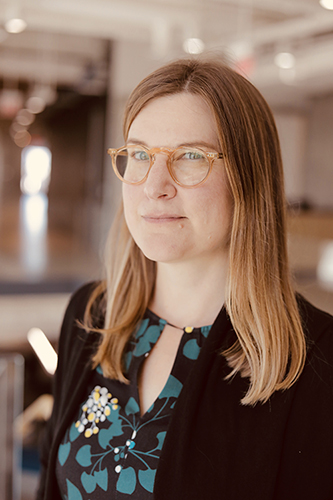


.png?sfvrsn=519c2f3c_1)